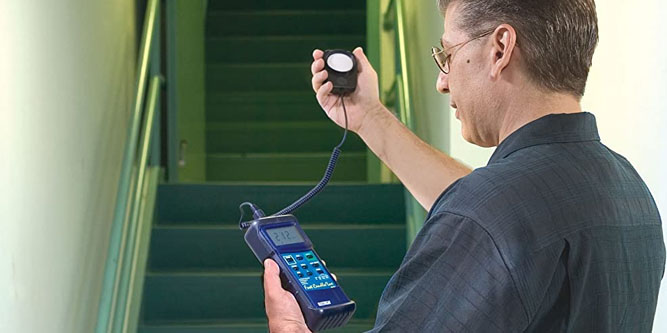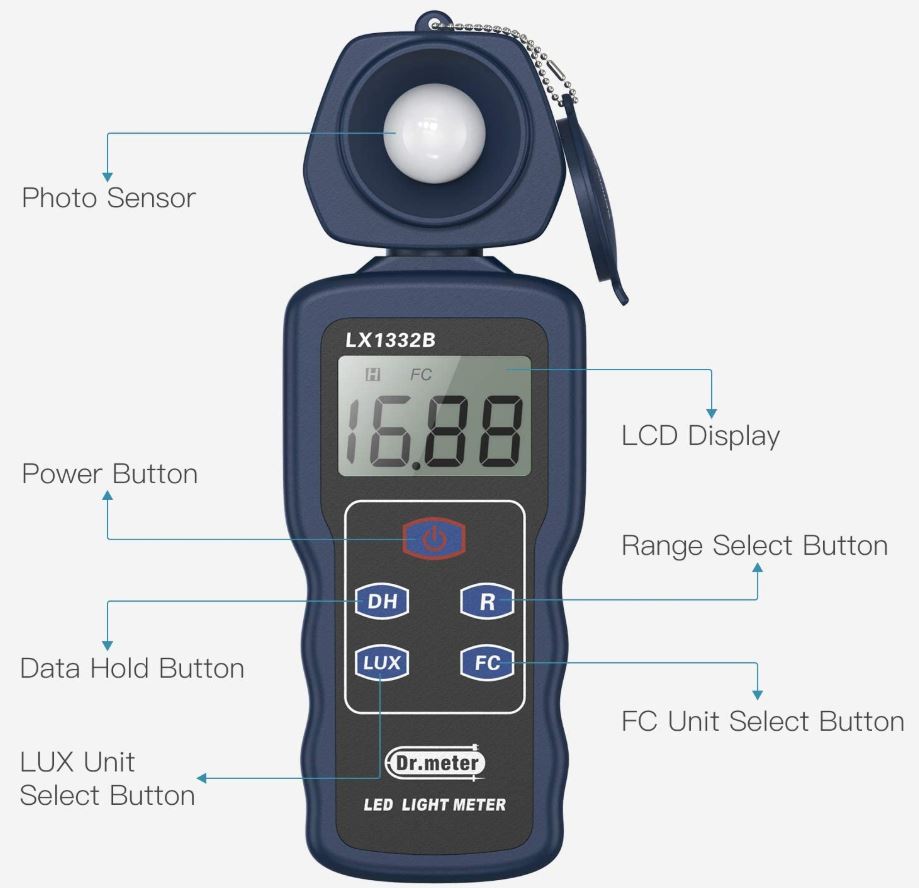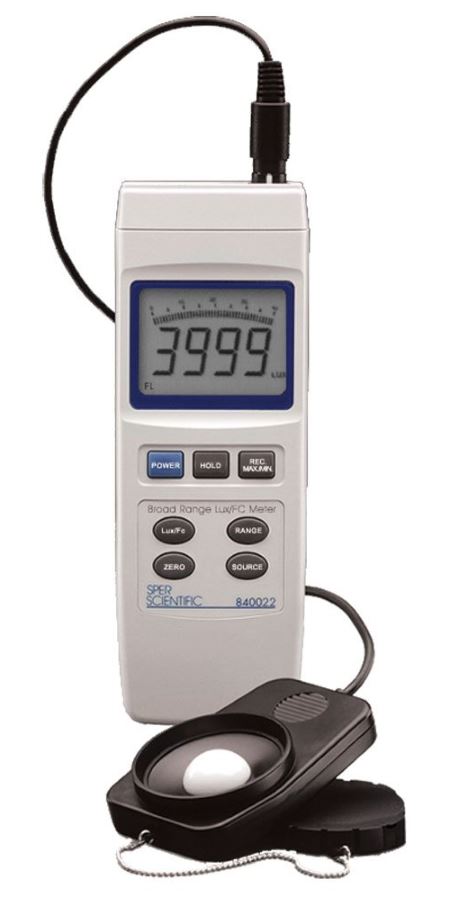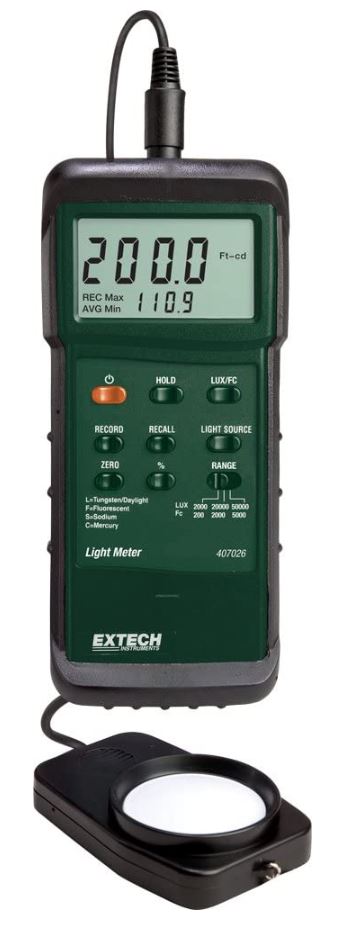Getting a good picture or a well-balanced video requires the right lighting. If you’re just snapping selfies for social media, you can always wing it. But for professional work, the light level and exposure time need to be matched. For video, this is even more important. Getting the same light balance from one location to another is essential for a professional look. CCTV cameras in stairwells and other locations also require sufficient lighting in order to be effective. Not only that, but good lighting is essential for safety. A well-lit stairway can make the difference between safe tenants and injuries and lawsuits. But how do you get the right light level?
The answer is to use a digital lux meter. These handy devices can tell you exactly how well-lit an area is. In an instant, you’ll know whether your stairwell is too dim. You’ll also know if your office space is bright enough to cause headaches. A good light meter will tell the difference between fluorescent, incandescent, high pressure sodium, and metal halide lights. It should also be easy to use.
Today, we’ll be reviewing three of these lux meters. First up is the Dr. Meter 1332B Digital Illuminance/Light Meter, a single piece unit that’s easy to use. Next, we’ll look at the Sper Scientific 840022 Advanced Light Meter, which features a removable sensor. Finally, we’ll be looking at the Extech 407026 Light Meter. All three of these tools will get the job done, but they have different advantages and disadvantages. Let’s take a closer look, and see which one is right for you!
Dr. Meter 1332B Digital Illuminance/Light Meter
The Dr. Meter 1332B Digital Illuminance/Light Meter is an all-in-one light meter that weighs 11.2 ounces. It measures 8 inches long, 4.2 inches wide, and 2.3 inches thick, the perfect size to hold in your hand. The blue ABS plastic case has molded finger grooves, but you don’t have to carry it. Thanks to the screw base, you can mount it on a tripod to keep it stable. On top, you’ll find the light sensor, along with a tethered, detachable cap. The cap will keep the sensor protected during storage, preventing scratches and other damage. During operation, the sensor can be rotated 270 degrees. This lets you check the light level in an entire room without having to physically move the device.
On the front panel, you’ll see five rubbery buttons that allow for easy operation. The top button controls the power, and the bottom two allow you to switch between lux and foot candles (Fc). The DH button activates the data hold function, and the R button lets you adjust the range. Above the buttons, there’s a 4-digit LCD display, which is easy to read under most lighting conditions.
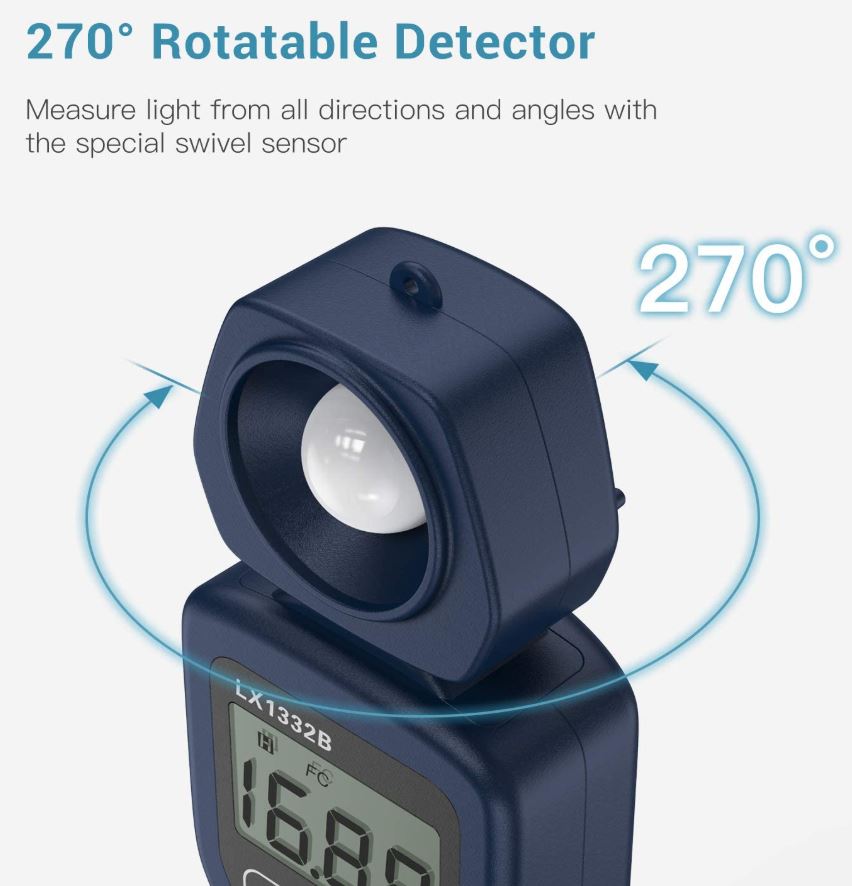
In addition to the light meter, the kit includes everything you need to get started. You get a zippered canvas carrying bag, which is sturdy enough to prevent most damage. You also get an owner’s manual, as well as a 9-volt battery. The rated battery life is 200 hours, enough for months of even very heavy use.
Sensitivity & Performance
The 1332B is so simple to use, anybody can do it. Turn it on, and it will immediately start displaying the current light level. The reading displays in a 4-digit format, so you might need to change the range to get an effective reading. Pressing the Lux button repeatedly will cycle through 200 lux, 2,000 lux, 20,000 lux, and 200,000 lux ranges. If you prefer to use foot candles, you can also do that. Fc ranges are 0.01-20 Fc, 200 Fc, 2,000 Fc, and 20,000 Fc. For lower ranges (less than 20,000 lux), the accuracy is +/- 4 percent. At higher ranges (over 20,000 lux), the accuracy is +/- 5 percent. This isn’t quite as good, but it’s still sufficient for most purposes.
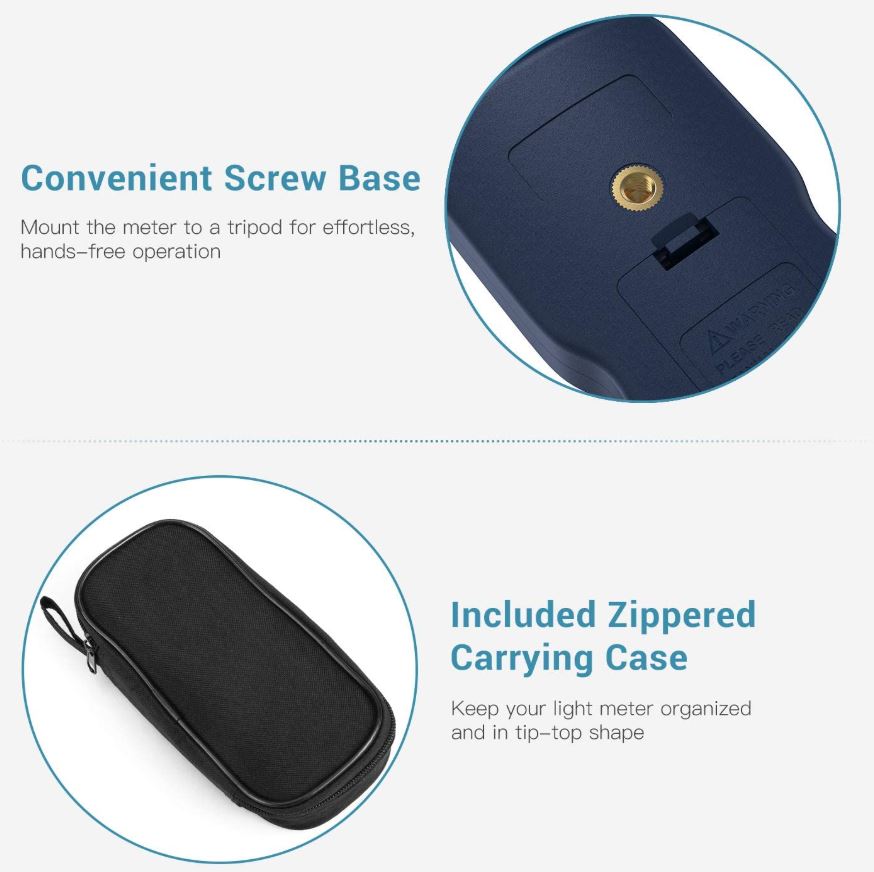
In addition to measuring light level, the Dr. Meter 1332B can also measure the light temperature. It’s accurate to +/-0.1 percent, which makes it suitable for any kind of lighting. Fluorescent, incandescent, metal halide, or high pressure sodium, it makes no difference. Moreover, it can operate in a variety of temperature conditions. As long as the temperature is above freezing and below 104 degrees Fahrenheit, it will work just fine. It measures the light level twice every second, so you don’t have to wait to get an accurate reading. Slowly rotate the sensor around the room, and you’ll quickly get a take on the light level in every area.
In addition to basic functions, the 1332B can also store readings by using the data hold function. This gives you time to write it down and take notes. It even has an auto power off function. Forget to shut down because you were busy? No worries. The 1332B will save your battery from running dry in storage.
Sper Scientific 840022 Advanced Light Meter
The Sper Scientific 840022 Advanced Light Meter is similar in size to the Dr. Meter, but different in function. It weighs 10 ounces, and measures 7.75 inches tall, 2.75 inches wide, and 1.25 inches thick. However, the light sensor is separate from the main unit. A plug connects into the top of the unit, and the small, handheld sensor can be easily moved around. The cable is only about a foot long, which isn’t that long, but good enough to get the job done. And the sensor has a removable cover for protection.
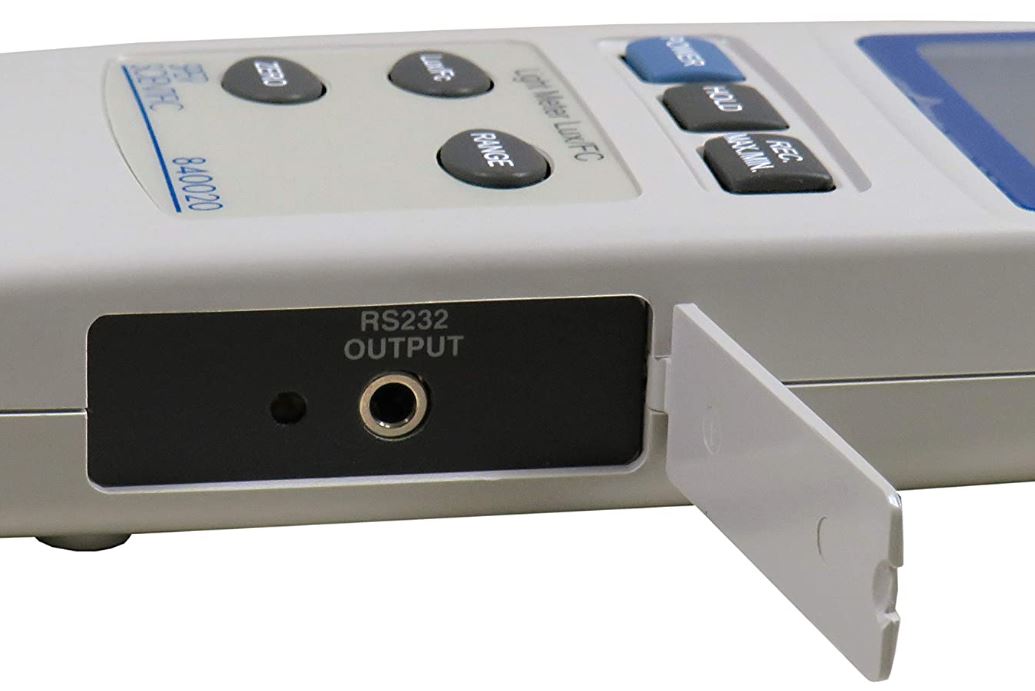
The Sper Scientific 840022’s control panel is a bit more advanced than the Dr. Meter’s. At the top, it has a power and data hold button. However, it also has a max/min button. This function allows you to restrict your readings separately from the range function. Dark corners and individual bright spots will be ignored, letting you focus on the room overall. You can also switch between lux and foot candles, as well as set the light source type. This is a bit different from the Dr. Meter’s automatic sensing, and we’ll get into it in a second. The four-digit LCD display is easy to read, and should be good enough for most purposes.
Because the 840022’s light sensor is separate from the main unit, it doesn’t need to be tripod-mounted. Instead, it has a built-in stand that’s designed to be set on a table. This makes it easy to use with one hand. In addition to the unit itself, you also get a few accessories. The instruction manual is to be expected, but there’s a traceable N.I.S.T certificate of calibration available. This can help protect you from liability. A 9-volt battery comes with the kit, along with a soft padded case. The case even has a shoulder strap, which makes it easy to transport.
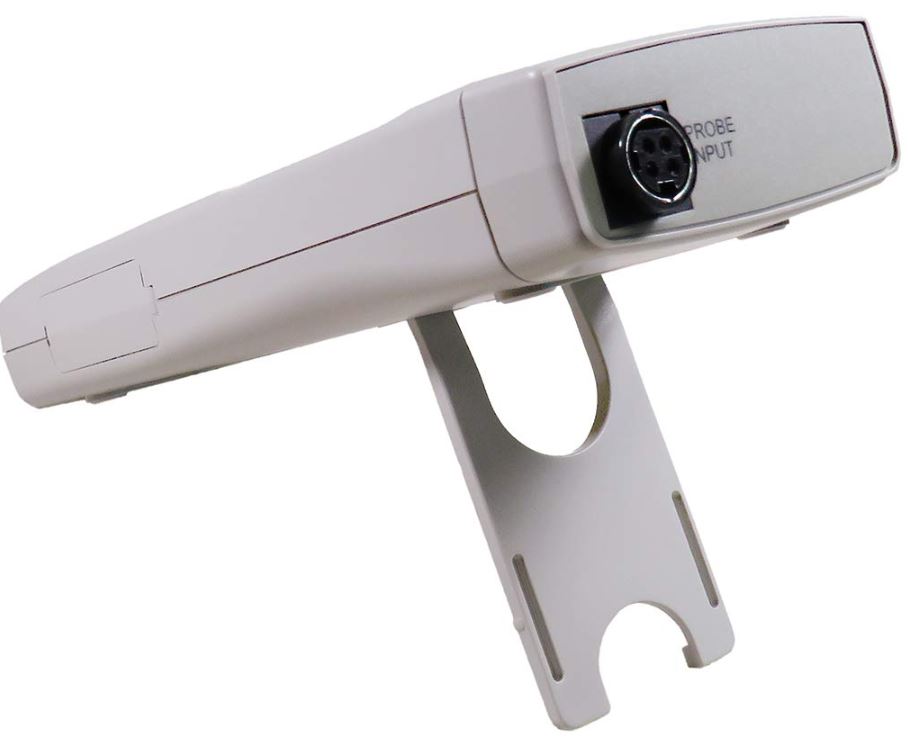
Sensitivity & Performance
The Sper Scientific 840022 has a range of up to 400,000 lux. Forget about indoor use. This lux meter is ideally-suited for outdoor use. Wedding photos and professional video will be a breeze, with no issues with maxing out the meter. The foot candle range is similarly impressive, running as high as 40,000 Fc. The overall sensitivity is +/-3 percent, which is even better than the Dr. Meter’s.
In addition to being exceptionally sensitive, the 840022 can also compensate for different light sources. Use the source button, and you can cycle through incandescent, fluorescent, and other types of light. The source type will be displayed at the bottom of the LCD display, which keeps things simple. This function means you can compensate for light color much more easily than with most lux meters. And, like the Dr. Meter, the Sper Scientific meter has an auto-off feature. You’ll never run out of juice just because you forgot to hit the power button.
Extech 407026 Light Meter
The Extech 407026 Light Meter is the most compact choice on our list. It weighs just 6.4 ounces, and measures 7 inches long, 2.9 inches wide, and 1.3 inches thick. This relatively small form factor makes it ideal for transport, especially if you carry a large toolkit already. Even at this size, it still has a large 4-digit LCD display, which measures 1.4 inches high. It displays in both lux and foot candles simultaneously, so there’s no need to switch back and forth.
Like the Sper Scientific 840022, the Extech’s sensor is separate from the main unit, and is tethered by a cable. That said, the cable is significantly longer, at 45 inches. This makes operation easy, particularly when you prop the 840022 up on its built-in stand. Set it up, move the sensor around the room, and you’re ready to go.
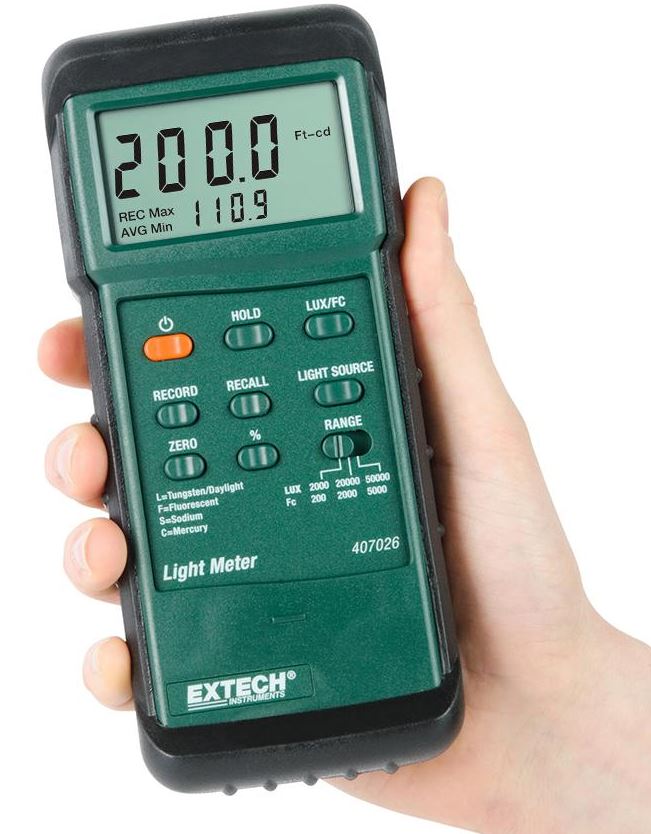
In addition to the built-in stand, the 840022 also has a built-in battery. On the one hand, it’s non-standard. On the other hand, it’s rechargeable, so you don’t have to worry about swapping out batteries. You also get a holster, which makes the 840022 easy to stow on your belt. Carry it in your toolbag, or keep it on your belt for quick, easy access. Finally, you get a 3-year manufacturer’s warranty. This ensures that you’re protected if anything goes wrong.
Sensitivity & Performance
When it comes to sensitivity, the Extech 407026 is geared towards the low end. It has three lux ranges you can cycle through: 2,000 lux, 20,000 lux, and 50,000 lux. This makes it better suited for indoor use than for outdoor use. Similarly, the foot candle range is relatively low. It covers up to 200, 2,000, or 5,000 Fc. The overall accuracy is +/-4 percent, which makes it reasonably accurate given the range. It samples every 0.4 seconds, which makes it easy to sweep a room and pick up readings as you go.
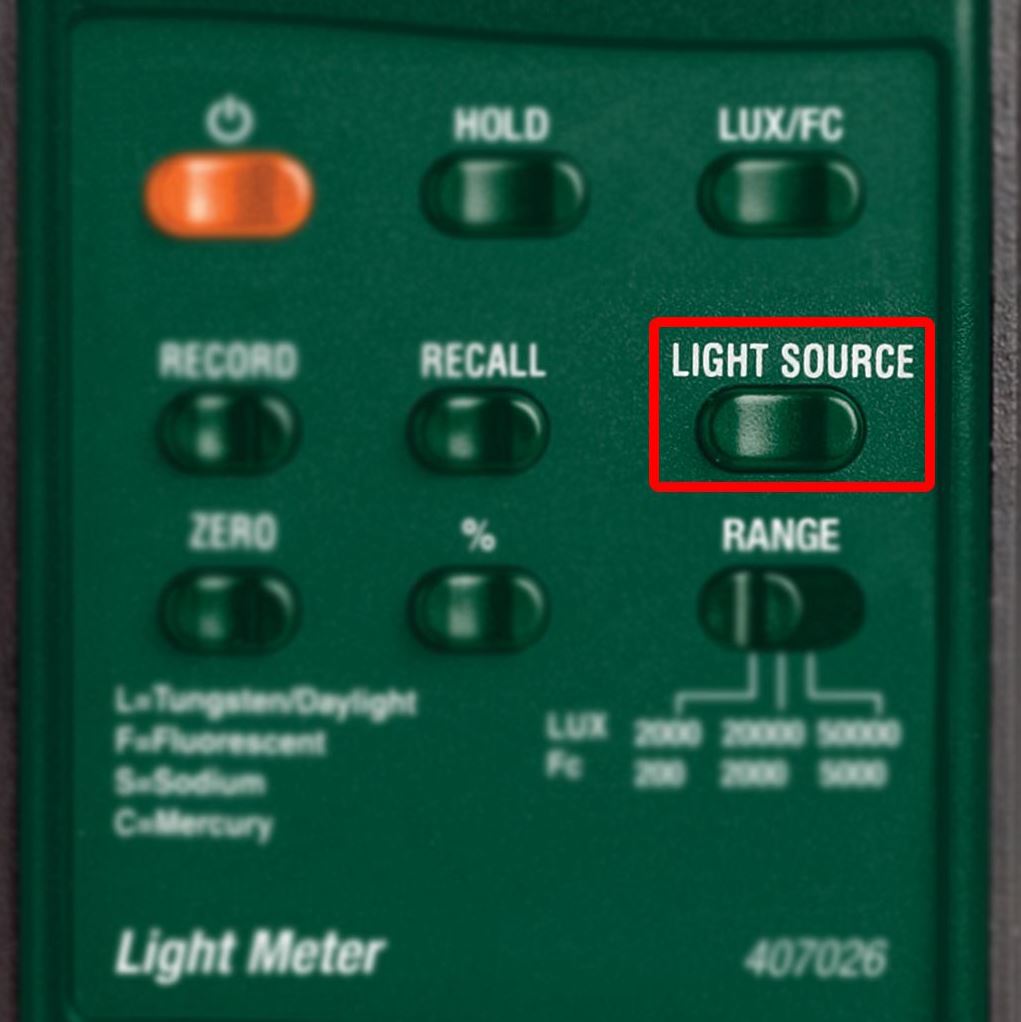
The Extech 407026 is designed to deal with a variety of lighting types. Using the Light Source button, you can switch between tungsten/daylight, fluorescent, sodium, and mercury light sources. Using the Data Hold button, you can freeze a displayed reading. This makes it easy to write down your readings as you go. In addition, you can set a reference point, then display a percentage differential from that reference. This is useful for photography and film purposes. Finally, you can use the Max/Min button to record the highest and lowest readings in an area. This allows you to get a good sense of the total lighting range in the room. There’s even an Average button to collect the average light rating in the room.
In addition, the Extech 407026 has an optional Windows software package for data storage. You can use this package to save data for later recovery, or to track light conditions over time. This isn’t useful for photography. But for industrial purposes, it’s a valuable tool. Like our other choices, the 407026 also has an automatic shut-off feature to protect your battery.
Final Verdict
So, which one of these lux meters is the best? As is so often the case, it depends on what you’re trying to do. If you’re looking for a lux meter for indoor, industrial purposes, the Extech 407026 Light Meter is the best choice. The low range is limiting for ultra bright scenarios. But the Windows software and tracking features are great for protecting you from liability. By contrast, the Sper Scientific 840022 Advanced Light Meter is ideal for outdoor photography and filming. Its range of up to 400,000 lux provides you with the ability to track light levels even in broad daylight.
If you’re looking for an all-around choice for all scenarios, consider the Dr. Meter 1332B Digital Illuminance/Light Meter. This device provides a good balance of wide range and low-light sensitivity. Ultimately, any of these options will be a good choice for most scenarios. But by tailoring your purchase to your needs, you’ll end up getting the best possible option.
Meet Ry, “TechGuru,” a 36-year-old technology enthusiast with a deep passion for tech innovations. With extensive experience, he specializes in gaming hardware and software, and has expertise in gadgets, custom PCs, and audio.
Besides writing about tech and reviewing new products, he enjoys traveling, hiking, and photography. Committed to keeping up with the latest industry trends, he aims to guide readers in making informed tech decisions.

